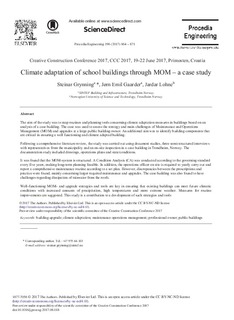| dc.contributor.author | Grynning, Steinar | |
| dc.contributor.author | Gaarder, Jørn Emil | |
| dc.contributor.author | Lohne, Jardar | |
| dc.date.accessioned | 2017-09-15T12:10:25Z | |
| dc.date.available | 2017-09-15T12:10:25Z | |
| dc.date.created | 2017-09-13T12:39:47Z | |
| dc.date.issued | 2017 | |
| dc.identifier.citation | Procedia Engineering. 2017, 196 864-871. | nb_NO |
| dc.identifier.issn | 1877-7058 | |
| dc.identifier.uri | http://hdl.handle.net/11250/2454871 | |
| dc.description.abstract | The aim of the study was to map routines and planning tools concerning climate adaptation measures in buildings based on an analysis of a case building. The case was used to assess the strategy and main challenges of Maintenance and Operations Management (MOM) and upgrades at a large public building owner. An additional aim was to identify building components that are critical in ensuring a well functioning and climate adapted building. Following a comprehensive literature review, the study was carried out using document studies, three semi-structured interviews with representatives from the municipality and an on-site inspection in a case building in Trondheim, Norway. The documentation study included drawings, operations plans and state/conditions. It was found that the MOM-system is structured. A Condition Analysis (CA) was conducted according to the governing standard every five years, making long-term planning feasible. In addition, the operations officer on site is required to yearly carry out and report a comprehensive maintenance routine according to a set plan. However, discrepancies between the prescriptions and practice were found, mainly concerning larger required maintenance and upgrades. The case building was also found to have challenges regarding dissipation of rainwater from the roofs. Well-functioning MOM- and upgrade strategies and tools are key in ensuring that existing buildings can meet future climatic conditions with increased amounts of precipitation, high temperatures and more extreme weather. Measures for routine improvements are suggested. This study is a contribution to a development of such strategies and tools. Keywords: building upgrade; climate adaptation; maintenance operations management; professional owner; public buildings | nb_NO |
| dc.description.abstract | The aim of the study was to map routines and planning tools concerning climate adaptation measures in buildings based on an analysis of a case building. The case was used to assess the strategy and main challenges of Maintenance and Operations Management (MOM) and upgrades at a large public building owner. An additional aim was to identify building components that are critical in ensuring a well functioning and climate adapted building.
Following a comprehensive literature review, the study was carried out using document studies, three semi-structured interviews with representatives from the municipality and an on-site inspection in a case building in Trondheim, Norway. The documentation study included drawings, operations plans and state/conditions.
It was found that the MOM-system is structured. A Condition Analysis (CA) was conducted according to the governing standard every five years, making long-term planning feasible. In addition, the operations officer on site is required to yearly carry out and report a comprehensive maintenance routine according to a set plan. However, discrepancies between the prescriptions and practice were found, mainly concerning larger required maintenance and upgrades. The case building was also found to have challenges regarding dissipation of rainwater from the roofs.
Well-functioning MOM- and upgrade strategies and tools are key in ensuring that existing buildings can meet future climatic conditions with increased amounts of precipitation, high temperatures and more extreme weather. Measures for routine improvements are suggested. This study is a contribution to a development of such strategies and tools.
Keywords: building upgrade; climate adaptation; maintenance operations management; professional owner; public buildings | nb_NO |
| dc.language.iso | eng | nb_NO |
| dc.publisher | Elsevier Ltd. | nb_NO |
| dc.rights | Attribution-NonCommercial-NoDerivatives 4.0 Internasjonal | * |
| dc.rights.uri | http://creativecommons.org/licenses/by-nc-nd/4.0/deed.no | * |
| dc.subject | Drift og vedlikeholdsteknikk | nb_NO |
| dc.subject | Operation and maintenance | nb_NO |
| dc.subject | Klimatilpasning | nb_NO |
| dc.subject | Climate change adaptation | nb_NO |
| dc.subject | Bygningsoppgradering | nb_NO |
| dc.subject | Building upgrade | nb_NO |
| dc.title | Climate Adaptation of School Buildings through MOM – A Case Study | nb_NO |
| dc.type | Journal article | nb_NO |
| dc.type | Peer reviewed | nb_NO |
| dc.description.version | publishedVersion | nb_NO |
| dc.rights.holder | © 2017 The Authors. This is an open access article under the CC BY-NC-ND license (http://creativecommons.org/licenses/by-nc-nd/4.0/). | nb_NO |
| dc.subject.nsi | VDP::Teknologi: 500 | nb_NO |
| dc.subject.nsi | VDP::Technology: 500 | nb_NO |
| dc.source.pagenumber | 864-871 | nb_NO |
| dc.source.volume | 196 | nb_NO |
| dc.source.journal | Procedia Engineering | nb_NO |
| dc.identifier.doi | 10.1016/j.proeng.2017.08.018 | |
| dc.identifier.cristin | 1493315 | |
| dc.relation.project | Norges forskningsråd: 237859 | nb_NO |
| cristin.unitcode | 7401,30,40,0 | |
| cristin.unitname | Arkitektur, byggematerialer og konstruksjoner | |
| cristin.ispublished | true | |
| cristin.fulltext | original | |
| cristin.qualitycode | 1 | |

